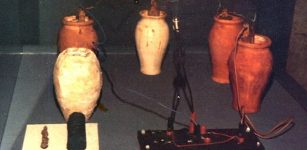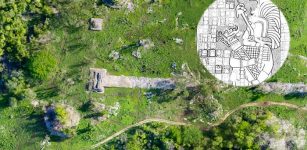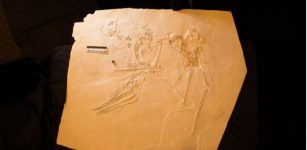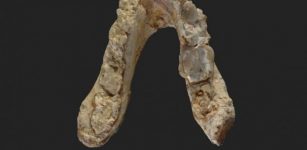Why Is La Ferrassie Man A Unique And Famous Neanderthal?
Jan Bartek - AncientPages.com - Scientists have unearthed the remains of hundreds of Neanderthals, but until this day, no one is as unique and famous as the La Ferrassie Man (LF1).
The skull of La Ferrassie 1 on display at Wollaton Hall in Nottingham, UK. Credit: Mike Peel - CC BY-SA 4.0
The Neanderthal was discovered at the La Ferrassie rock shelter in the Dordogne Valley, France in 1909. At the site were also the remains of an adult woman and several Neanderthal children. How and why all these individuals ended up in the cave has long intrigued scientists, but it seems it is a case of intentional burial. The rock shelter was repeatedly occupied by Neanderthals during millennia.
The famous Neanderthal’s skeleton has been dated to between 40,000 and 54,000 years. Studies of LF1’s remains revealed La Ferrassie Man was about 50 years at the time of his death. Scientists have not been able to determine the lifespan of Neanderthals, but finding an individual who lived more than 45 years is rare, which is why La Ferrassie Man is considered an old man. He was also around 171 centimeters (5 feet and 7 inches) tall, and his leg and foot bones clearly showed he could walk upright, just like humans.
The Neanderthal suffered various broken bones during his lifetime and had ongoing respiratory issues when he died. Neanderthal cultural practices are often discussed. Was burial of the dead practiced by Neandertals, or is it an innovation specific to our species? Were Neanderthals really capable of such cultural sophistication? Though some scientists remain skeptical, there is evidence the Neanderthals did bury their dead.
Researchers say La Ferrassie Man was deliberately buried in the pit by other members of his social group.
The skeleton of La Ferrassie Man is “one of the most important Neanderthal individuals both for its completeness and due to the important role it has played historically in the interpretation of Neanderthal anatomy and lifeways.” 1
His skull, the largest and most complete Neanderthal skull ever found, has “many of the typical Neanderthal traits such as the low, sloping forehead and large nasal opening.” 2
His front incisors show a slanted wear that does not occur from chewing; one hypothesis to explain this odd wear on his teeth is that he habitually held something in place between his front teeth, such as a hide, that he then scraped with a tool. Although this hypothesis has been debated, the use of the teeth as tools may represent a remarkable Neanderthal behavioral adaptation.” 3
La Ferrassie Man is an extraordinary scientific discovery that still provides new insights into Neandertal anatomy and behavior.
Written by Jan Bartek - AncientPages.com Staff Writer
Copyright © AncientPages.com All rights reserved. This material may not be published, broadcast, rewritten or redistributed in whole or part without the express written permission of AncientPages.com
- Binghamton University - New technology reveals secrets of famous Neandertal skeleton, La Ferrassie 1
- Smithsonian Institution Human Origins - La Ferrassie
- Asier Gómez-Olivencia, Rolf Quam, Nohemi Sala, Morgane Bardey, James C. Ohman, Antoine Balzeau. La Ferrassie 1: New perspectives on a “classic” Neandertal. Journal of Human Evolution, 2018; 117: 13 DOI: 10.1016/j.jhevol.2017.12.004
- Jean-Pierre Bocquet-Appel and Anna Degioanni - Neanderthal Demographic Estimates
More From Ancient Pages
-
 Pena Molexa (Lunar Boat): Megalithic Corner Dedicated To A Magician Woman Who Knows The Secrets Of Earth And Underworld
Featured Stories | Jul 23, 2023
Pena Molexa (Lunar Boat): Megalithic Corner Dedicated To A Magician Woman Who Knows The Secrets Of Earth And Underworld
Featured Stories | Jul 23, 2023 -
 Ancient City Of Troy Was Destroyed By An Earthquake That Ended The Trojan War – Archaeologists Say
Archaeology | Jun 14, 2017
Ancient City Of Troy Was Destroyed By An Earthquake That Ended The Trojan War – Archaeologists Say
Archaeology | Jun 14, 2017 -
 Jiangshi – Terrifying Vicious Ancient Chinese Vampire In Disguise
Chinese Mythology | Jun 11, 2020
Jiangshi – Terrifying Vicious Ancient Chinese Vampire In Disguise
Chinese Mythology | Jun 11, 2020 -
 Was Prehistoric Baghdad Battery A Unique Find Of The Ancients? – Did Its Manufacturers Discover Electricity By Accident?
Ancient Technology | Mar 8, 2019
Was Prehistoric Baghdad Battery A Unique Find Of The Ancients? – Did Its Manufacturers Discover Electricity By Accident?
Ancient Technology | Mar 8, 2019 -
 Nabataean Culture Lived On Long After Their Kingdom Disappeared – New Evidence
Archaeology | Feb 27, 2019
Nabataean Culture Lived On Long After Their Kingdom Disappeared – New Evidence
Archaeology | Feb 27, 2019 -
 Apsara Carvings Dated To 12th Century Uncovered At Takav Gate In Angkor, Cambodia
Archaeology | May 5, 2022
Apsara Carvings Dated To 12th Century Uncovered At Takav Gate In Angkor, Cambodia
Archaeology | May 5, 2022 -
 Unusual Celestial Phenomenon Observed In Ancient Egypt 3,500 Years Ago
Ancient Mysteries | Aug 10, 2015
Unusual Celestial Phenomenon Observed In Ancient Egypt 3,500 Years Ago
Ancient Mysteries | Aug 10, 2015 -
 Mysterious Ancient Site Of Çatalhöyük: Remains Of Early Structures May Shed More Light On Its Obscure Past
Archaeology | Apr 11, 2017
Mysterious Ancient Site Of Çatalhöyük: Remains Of Early Structures May Shed More Light On Its Obscure Past
Archaeology | Apr 11, 2017 -
 Did The Dogon Tribe Have Knowledge Of Theoretical Physics 5,000 Years Ago?
Ancient Mysteries | Aug 2, 2017
Did The Dogon Tribe Have Knowledge Of Theoretical Physics 5,000 Years Ago?
Ancient Mysteries | Aug 2, 2017 -
 The 100-Kilometer-Long Stone Highway That Connected Ancient Maya Cities Revealed By LIDAR
Archaeology | Feb 25, 2020
The 100-Kilometer-Long Stone Highway That Connected Ancient Maya Cities Revealed By LIDAR
Archaeology | Feb 25, 2020 -
 Is The Poverty Point Octagon World’s Largest Ancient Solstice Marker?
Featured Stories | May 21, 2017
Is The Poverty Point Octagon World’s Largest Ancient Solstice Marker?
Featured Stories | May 21, 2017 -
 DNA Sheds New Light On The Mysterious Dead Sea Scrolls
Archaeology | Jun 2, 2020
DNA Sheds New Light On The Mysterious Dead Sea Scrolls
Archaeology | Jun 2, 2020 -
 Cherokee Gourd Rattles – Protection Against Evil Spirits And Other Danger
Ancient Traditions And Customs | Jun 7, 2019
Cherokee Gourd Rattles – Protection Against Evil Spirits And Other Danger
Ancient Traditions And Customs | Jun 7, 2019 -
 New Fossil Of 145-Million-Year-Old Pterosaur Nicknamed Elvis
Fossils | Jul 14, 2023
New Fossil Of 145-Million-Year-Old Pterosaur Nicknamed Elvis
Fossils | Jul 14, 2023 -
 Secret Ancient Knowledge Of Portals Leading To Unknown Realms -The Arrival And Departure – Part 1
Ancient Mysteries | Dec 1, 2021
Secret Ancient Knowledge Of Portals Leading To Unknown Realms -The Arrival And Departure – Part 1
Ancient Mysteries | Dec 1, 2021 -
 Mysterious Rock Art By Unknown Ancient Culture Found In Venezuela
Archaeology | Jul 5, 2024
Mysterious Rock Art By Unknown Ancient Culture Found In Venezuela
Archaeology | Jul 5, 2024 -
 Why Is The Hungry Ghost Festival Celebrated In August?
Ancient Traditions And Customs | Aug 12, 2019
Why Is The Hungry Ghost Festival Celebrated In August?
Ancient Traditions And Customs | Aug 12, 2019 -
 7.2-Million-Year-Old Pre-Human Remains Suggest Our First Ancestor Came From Europe Not Africa
Archaeology | May 23, 2017
7.2-Million-Year-Old Pre-Human Remains Suggest Our First Ancestor Came From Europe Not Africa
Archaeology | May 23, 2017 -
 Burial Chamber Of Ankhesenamun, Tutankhamun’s Wife May Soon Be Found
Archaeology | Jan 22, 2018
Burial Chamber Of Ankhesenamun, Tutankhamun’s Wife May Soon Be Found
Archaeology | Jan 22, 2018 -
 Utiseta – Norse Vision Quest – Ancient Spiritual Tradition Of Northern Europe
Ancient Mysteries | Oct 3, 2019
Utiseta – Norse Vision Quest – Ancient Spiritual Tradition Of Northern Europe
Ancient Mysteries | Oct 3, 2019

